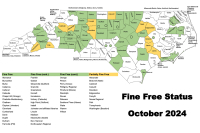I have seen the light
 I have seen the light, and I don’t like it. I have seen the light emanating from strip malls; from sports stadiums; from urban skylines; from cul-de-sacs; from factories; from almost any place twilight finds Homo sapiens and I don’t like it.
I have seen the light, and I don’t like it. I have seen the light emanating from strip malls; from sports stadiums; from urban skylines; from cul-de-sacs; from factories; from almost any place twilight finds Homo sapiens and I don’t like it.
I don’t like it because I can’t see the stars; I can’t touch the heavens; I can’t revel in the firmament of dying and exploding suns; I can’t see the stuff I’m made of.
It wasn’t always so. Our ancestors had an intimate relationship with the night skies. Ancient mariners would have never docked without Polaris. And where would science be without Copernicus and Galileo?
The heavens have always reflected thoughts of beauty, love, imagination, philosophy, literature and awe. “I know that I am mortal by nature, and ephemeral; but when I trace at my pleasure the windings to and fro of the heavenly bodies I no longer touch the earth with my feet: I stand in the presence of Zeus himself and take my fill of ambrosia” — Ptolemy.
I love it when the night sky plops to the ground like a curtain dragging across a stage, when the stars actually twinkle and the eye of Taurus glows red. My co-workers thought me a bit daft, when I worked as an offshore surveyor in the Gulf of Mexico because I would always volunteer if one of the survey points was on an abandoned platform. Sure it would mean no cooked meal, no hot shower and gasp, no television, but it would mean being bathed in starlight from dusk till dawn and I was OK with the tradeoff.
Light pollution (the illumination of the night sky caused by artificial light) is increasing (at the speed of light?) around the world since the invention of the incandescent bulb 125 years ago. It is estimated that today, fully two-thirds of Americans cannot walk outside at night, look up and see the Milky Way. And even more than that are affected in some way by light pollution.
Related Items
International Dark-Sky Association (IDA,) created in 1988, was the first organization to call attention to the perils of light pollution. IDA is still in the forefront when it comes to seeking, promoting and helping to implement programs/procedures that can limit and/or reduce the impacts of light pollution. It has a wonderful website — www.darksky.org — where you can go to learn about light pollution and its sources, causes, remedies, etc.
Unlike many of the environmental challenges facing us, light pollution, is something we have the technologies and abilities to deal with right now. And instead of costing us money, most light pollution remedies will save money. According to IDA, the United States spends over $2 billion on light-energy that only serves to blot out the night skies. You can learn about many alternatives and how to support them on the IDA website or you can call them at 1.520.293.3198 and request information.
IDA also has a program where it recognizes places of exceptional nighttime beauty. There are still a few left in the U.S. and one, listed in their “International Dark Sky Parks” — Big Bend National Park — still sings to me. A group of friends and I took a float trip out to Big Bend back in the 1970s and between Santa Elena Canyon and Mariscal Canyon we slept in the dessert — one of those places where night’s curtain drags across the stage, and one of those places that leaves a scar on your soul.
(Don Hendershot is a writer and naturalist. He can be reached a This email address is being protected from spambots. You need JavaScript enabled to view it..)









